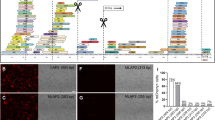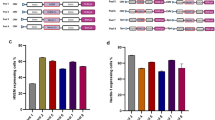Abstract
Herpesvirus saimiri (HVS) is capable of establishing a persistent infection in a variety of human carcinoma cell lines, by virtue of episomal maintenance. Moreover, the viral episome provides expression of a transgene in both in vitro and in vivo environments. At present, HVS vectors utilize heterologous promoters such as the IE hCMV promoter. However, this promoter maybe unsuitable for long-term expression in vivo, as promoter silencing has been observed in this and other herpesvirus-based vector systems. Ideal regulatory regions would be functional when the herpesvirus genome is maintained as a latent episome. We have previously shown that gene expression in an HVS-persistently-infected human carcinoma cell line is limited to an adjacent set of genes encoding ORFs 71–73. These genes are transcribed as a polycistronic mRNA species from a common regulatory region upstream of the ORF 73 gene. In this report, we assess the potential of the ORF 73 regulatory region to provide heterologous gene expression in a wide variety of human cancer cell lines. We demonstrate, utilizing transient transfection assays, that the ORF 73 regulatory region can provide transgene expression in a variety of human carcinoma cell lines, although levels of transgene expression are not as high as achieved under the control of heterologous promoters such as the IE hCMV promoter. Furthermore, incorporation of the minimal ORF 73 regulatory region in a recombinant HVS-based vector provides sustained expression of the green fluorescent protein in both in vitro and in vivo environments. These results suggest that the ORF 73 regulatory region may be suitable for use in HVS-based cancer gene therapy applications.
This is a preview of subscription content, access via your institution
Access options
Subscribe to this journal
Receive 12 print issues and online access
$259.00 per year
only $21.58 per issue
Buy this article
- Purchase on Springer Link
- Instant access to full article PDF
Prices may be subject to local taxes which are calculated during checkout






Similar content being viewed by others
References
Hammerschmidt W . Herpesvirus vectors come of age. Curr Opin Mol Ther. 2000; 2: 532–539.
Coffin RS & Latchman DS . Herpes simplex virus-based vectors. In: Latchman DS, ed. Genetic Manipulation of the Nervous System. London: Academic Press; 1996; 99–111.
Glorioso JC, DeLuca NA & Fink DJ . Development and application of herpes simplex virus vectors for human gene therapy. Annu Rev Microbiol. 1995; 49: 675–710.
Lachmann RH & Efstathiou S . Gene transfer with herpes simplex vectors. Curr Opin Mol Ther. 1999; 1: 622–632.
Krisky DM, Wolfe D & Goins WF, et al. Deletion of multiple immediate-early genes from herpes simplex virus reduces cytotoxicity and permits long-term gene expression in neurons. Gene Ther. 1998; 5: 1593–1603.
Samaniego LA, Neiderhiser L & DeLuca NA . Persistence and expression of the herpes simplex virus genome in the absence of immediate-early proteins. J Virol. 1998; 72: 3307–3320.
Kieff E . Epstein-Barr virus and its replication. In: Fields BN, Knipe DM, Howley PM, et al, eds. Fields Virology. 3rd ed. Philadelphia: Lippincott-Raven Publishers; 1996; 2343–2396.
Yates J, Warren N & Sugden B . Stable replication of plasmids derived from Epstein-Barr virus in various mammalian cells. Nature. 1985; 313: 812–815.
Cotter MA & Robertson ES . Molecular genetic analysis of herpesviruses and their potential use as vectors for gene therapy applications. Curr Opin Mol Ther. 1999; 1: 633–644.
Wade-Martins R, White RE & Kimura H, et al. Stable correction of a genetic deficiency in human cells by an episome carrying a 115 Kb genomic transgene. Nat Biotechnol. 2000; 18: 1311–1314.
Fleckenstein B & Desrosiers RC . Herpesvirus saimiri and herpesvirus alleles. In: Roizman B, ed. The Herpesviruses, vol. 1, New York: Plenum; 1982; 253–332.
Fickenscher H & Fleckenstein B . Herpesvirus saimiri. Philos Trans R Soc Lond. 2001; 356: 545–567.
Desrosiers RC, Bakker A & Kamine J, et al. A region of the Herpesvirus saimiri genome required for oncogenicity. Science. 1985; 228: 184–187.
Grassmann R & Fleckenstein B . Selectable recombinant herpesvirus saimiri is capable of persisting in a human cell line. J Virol. 1989; 63: 1818–1821.
Simmer B, Alt M & Buckreus I, et al. Persistence of selectable herpesvirus saimiri in various human haematopoietic and epithelial cell lines. J Gen Virol. 1991; 72: 1953–1958.
Stevenson AJ, Cooper M & Griffiths JC, et al. Assessment of herpesvirus saimiri as a potential human gene therapy vector. J Med Virol. 1999; 57: 269–277.
Hall KT, Giles MS & Goodwin DJ, et al. Analysis of gene expression in a human cell line stably transduced with herpesvirus saimiri. J Virol. 2000; 74: 7331–7337.
Smith PG, Coletta PL, Markham AF & Whitehouse A . In vivo episomal maintenance of a herpesvirus saimiri-based gene delivery vector. Gene Ther. 2001; 8: 1762–1769.
Hiller C, Wittmann S, Slavin S & Fickenscher H . Functional long-term thymidine kinase suicide gene expression in human T cells using a herpesvirus saimiri vector. Gene Ther. 2000; 7: 664–674.
Hiller C, Tamguney G & Stolte N, et al. Herpesvirus saimiri pathogenicity enhanced by thymidine kinase of herpes simplex virus. Virology. 2000; 278: 445–455.
Stevenson AJ, Clarke D & Meredith DM, et al. Herpesvirus saimiri-based gene therapy vectors maintain heterologous expression throughout mouse embryonic stem cell differentiation in vitro. Gene Ther. 2000; 7: 464–471.
Bestor TH . Gene silencing as a threat to the success of gene therapy. J Clin Invest. 2000; 105: 409–411.
Glorioso JC, DeLuca NA & Fink DJ . Development and application of herpes simplex virus vectors for human gene therapy. Annu Rev Microbiol. 1995; 49: 675–710.
Fink DJ & Glorioso JC . Herpes simplex virus–based vectors: problems and some solutions. Adv Neurol. 1997; 72: 149–156.
Stevens JG, Wagner EK & Devi-Rao GB, et al. RNA complementary to a herpesvirus alpha gene mRNA is prominent in latently infected neurons. Science. 1987; 235: 1056–1059.
Wagner EK & Bloom DC . Experimental investigation of herpes simplex virus latency. Clin Microbiol Rev. 1997; 10: 419–443.
Lachmann RH & Efstathiou S . Utilisation of the herpes simplex virus type-1 latency associated regulatory region to drive stable reporter gene expression in the nervous system. J Virol. 1997; 71: 3197–3207.
Smith C, Lachmann RH & Efstathiou S . Expression from the herpes simplex virus type 1 latency-associated promoter in the murine central nervous system. J Gen Virol. 2000; 81: 649–662.
Palmer JA, Branston RH & Lilley CE, et al. Development and optimization of herpes simplex virus vectors for multiple long-term gene delivery to the peripheral nervous system. J Virol. 2000; 74: 5604–5618.
Albrecht JC, Nicholas J & Biller D, et al. Primary structure of the herpesvirus saimiri genome. J Virol. 1992; 66: 5047–5058.
Stevenson AJ, Frolova-Jones E & Hall KT, et al. A Herpesvirus saimiri–based gene therapy vector with potential for use in cancer immunotherapy. Cancer Gene Ther. 2000; 7: 1077–1085.
Bird A . The essentials of DNA methylation. Cell. 1992; 70: 5–8.
Kronberg RD & Lorch Y . Chromatin-modifying and remodeling complexes. Curr Opin Genet Dev. 1999; 9: 148–151.
Honess RW, Gompels UA & Barrell BG, et al. Deviations from expected frequencies of CpG dinucleotides in herpesvirus DNAs may be diagnostic of differences in the states of their latent genomes. J Gen Virol. 1989; 70: 837–855.
Kass SU, Landsberger N & Wolffe AP . DNA methylation directs a time dependent repression of transcription initiation. Curr Biol. 1997; 7: 157–165.
Barlow BP . Methylation and imprinting: from host defence to gene regulation?. Science. 1993; 260: 309–310.
Paulson EJ & Speck SH . Differential methylation of Epstein-Barr virus latency promoters facilitates viral persistence in healthy seropositive individuals. J Virol. 1999; 73: 9959–9968.
Chen J, Ueda K & Sakakibara S, et al. Activation of latent Kaposi's sarcoma–associated herpesvirus demethylation of the promoter of the lytic transactivator. Proc Natl Acad Sci USA. 2001; 98: 4119–4124.
Goodwin DJ, Walters MS & Smith PG, et al. The Herpesvirus saimiri Rta/ORF 50 protein reactivates the lytic replication cycle in a persistently infected A549 cell line. J Virol. 2001; 75: 4008–4013.
Lukac DM, Renne R & Kirshner JR, et al. Reactivation of Kaposi's sarcoma–associated herpesvirus infection from latency by expression of the ORF 50 transactivator, a homolog of the EBV R protein. Virology. 1998; 252: 304–312.
Robertson KD, Hayward SD & Ling PD, et al. Transcriptional activation of the Epstein-Barr virus latency C promoter after 5-azacytidine treatment: evidence that demethylation at a single CpG site is crucial. Mol Cell Biol. 1995; 15: 6150–6159.
Schaefer BC, Strominger JL & Speck SH, et al. Host cell determined methylation of specific Epstein-Barr virus promoters regulates the choice between distinct viral latency programs. Mol Cell Biol. 1997; 17: 364–377.
Acknowledgements
We thank GE Blair (University of Leeds) for providing expression constructs used in this work, and Olusola Faluyi (Molecular Medicine Unit) for assistance with sectioning. This work was supported, in parts, by Grants to AW from The Candlelighters Trust, Yorkshire Cancer Research, and Association of International Cancer Research. MSG is a Wellcome Trust Clinical Research Training Fellow.
Author information
Authors and Affiliations
Corresponding author
Rights and permissions
About this article
Cite this article
Giles, M., Smith, P., Coletta, P. et al. The herpesvirus saimiri ORF 73 regulatory region provides long-term transgene expression in human carcinoma cell lines. Cancer Gene Ther 10, 49–56 (2003). https://doi.org/10.1038/sj.cgt.7700523
Received:
Published:
Issue Date:
DOI: https://doi.org/10.1038/sj.cgt.7700523



